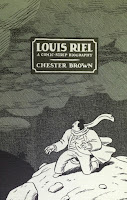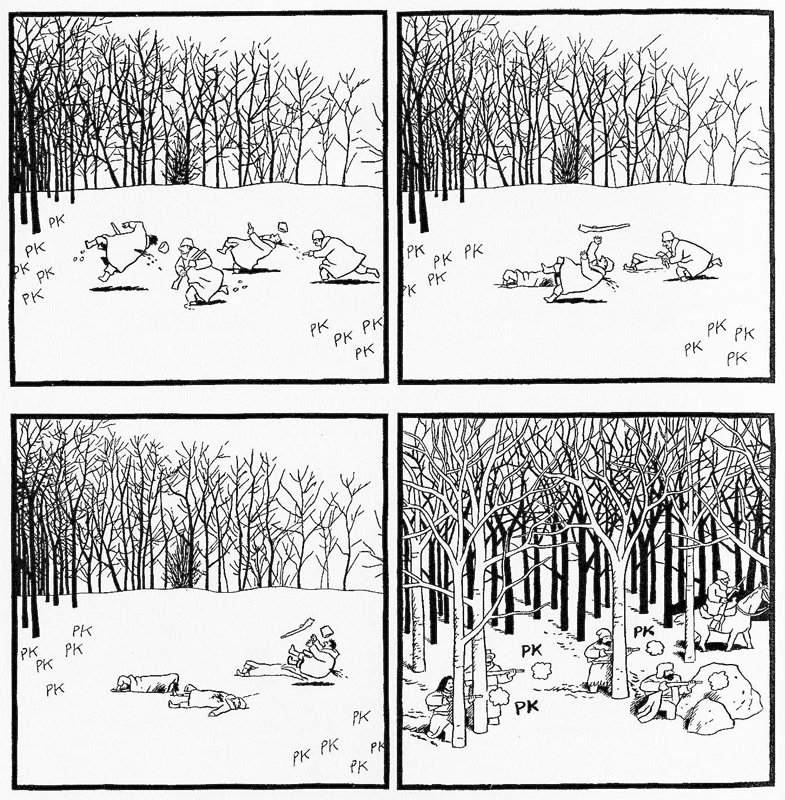I initially kept putting off reading Chester Brown's fictionalized biography on Louis Riel, intimidated by a combination of the book's massive size and the central importance of the character to Canada's national history. But I was also unsure what to make of the change in graphic style Brown adapted for the story. I thoroughly enjoyed reading his autobiographical explorations in The Playboy and I Never Liked You. So the approach used in Louis Riel didn't immediately appeal to me. But after getting over those concerns and finally diving into the work itself, I came to the conclusion that this is was one of the most engaging and beautiful comics that I've read in the last twenty years. That's quite a strong impression considering that its stark and minimal art, inspired by Harold Gray's Little Orphan Annie, stands in complete contrast to the increasingly lavish illustrative techniques and complex page layouts that have come to characterize some of the more notable examples of the medium. It's almost as if Brown set out to prove the viability of classic cartooning when applied to the modern graphic novel.
Brown's command of that language is remarkable. Despite my trepidation about the story's length, Louis Riel is a highly accessible narrative about a complex subject matter. In keeping with Harold Gray, Brown eschews dramatic close-ups, melodramatic displays of emotion, or changing panels arrangements. Even at its most intimate moments, Brown keeps the characters at middle distance. The characters are often portrayed at eye level or slightly above it, and usually in profile. Their faces are often masks that betray only subtle changes in emotions. The backgrounds are similarly sparse and the landscapes are very flat. This creates a certain theatrical staging for the characters' actions. There's also a quiet beauty and lonely majesty in many of the natural settings. Brown draws with clear and confident lines that require a minimum of fussy detailing and a strong sense of composition.
What such restraint does is allow the story to be told efficiently and with a minimum of distraction. The art conveys all the information necessary, allowing for an easy flow from panel to panel. The maintenance of an unchanging six panel grid also reinforces this. The caricature employed also effectively conveys each character's personalities without overselling it. Riel's spiky hair and unkempt appearance portray a certain directness that contrasts with the slyness portrayed by the bulbous nose and tweedy clothing of his nemesis Prime Minister John A. Macdonald. The uniformity of the panels isn't a hindrance when the story begins to focus on key events. Brown slows down the narrative with the use of a succession of barely changing images that adds to the gravitas of the proceedings. He also uses clever changes in the content of the panels to underline dramatic moments. The use of a blank white panel to show the moment of the Englishman Scott's death during his execution, or the use of black panels during Macdonald's decision to drive the Métis into rebellion, and during the jury's deliberation at Riel's trial. Deceptively simple, none of this minimalism is easy to accomplish.
For those unaware of what this book is all about, Louis Riel was a political leader of the Métis, a French translation for the Spanish "mestizo" - used in colonial times to describe people of mixed race. In the context of the story, the Métis were descendants of various European colonial (predominantly French speaking) and Native American populations. Riel would lead two armed rebellions against a primarily Anglophone Canadian government bent on limiting Métis representation within mainstream society. Eventually captured, tried, and executed, Riel was originally painted as a lunatic terrorist bent on the destruction of Canada. Today Riel's image has been largely rehabilitated as that of a freedom fighter who stood for the human rights of the Métis against the racist bigotry of the time. He's now recognized as a founder of the province of Manitoba.
This book isn't a comprehensive biography of Riel's life. Rather it focuses mainly on his political career. Brown's restraint also applies to his judgement on Riel's political legacy. Neither an unadulterated saint or a villain, Riel comes across as an astute and contradictory figure. A person who fought for the down-to-earth concerns of his people while being something of a religious fanatic. Was Riel a traitor or a patriot? Was he insane or simply intensely devoted? Was he a messianic figure, or a crackpot? Was he the rugged individualist standing up to the power of overbearing corporate interests and culpable state leaders, or a delusional thinker. Brown avoids giving pat answers to these questions. Sometimes this self-discipline has its downsides. For all his brilliance, it's never clear why Riel inspired such loyalty within the Métis community, especially when his convictions began to negatively impact the Métis cause. And Brown is unusually circumspect about exploring in greater depth the nature of Riel's clinically diagnosed insanity vs. his spiritual visions. Thus the book leaves his individual motivations unclear.
It should also be noted that as a work of historical fiction, Brown inevitably takes certain liberties with events in order to provide a clearer reading experience. But he is quite upfront about this and provides copious notes about how his interpretation differs from the actual facts of the events which are worth examining in themselves.
Louis Riel first appeared in serialized form before being collected into trade paperback. While the publisher still sells at least some the original pamphlets, I really can't imagine how the story benefits from having to consume it in serial installments. As far as I'm concerned, Louis Brown works better as a massive, singular tome.
Bonus: Kate Beaton has her own funny take on Riel.





